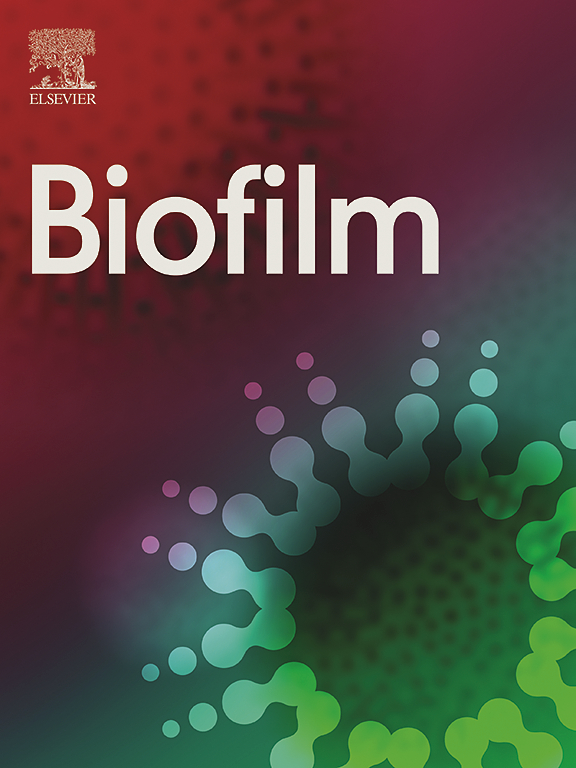Biofilm morphology and antibiotic susceptibility of methicillin-resistant Staphylococcus aureus (MRSA) on poly-D,L-lactide-co-poly(ethylene glycol) (PDLLA-PEG) coated titanium
IF 4.9
Q1 MICROBIOLOGY
引用次数: 0
Abstract
Biodegradable polymeric coatings are being explored as a preventive strategy for orthopaedic device-related infection. In this study, titanium surfaces (Ti) were coated with poly-D,L-lactide (PDLLA, (P)), polyethylene-glycol poly-D,L-lactide (PEGylated-PDLLA, (PP20)), or multi-layered PEGylated-PDLLA (M), with or without 1 % silver sulfadiazine. The aim was to evaluate their cytocompatibility, resistance to Staphylococcus aureus biofilm formation, and their potential to enhance the susceptibility of any biofilm formed to antibiotics. Using automated high-content screening confocal microscopy, biofilm formation of a clinical methicillin-resistant Staphylococcus aureus (MRSA) isolate expressing GFP was quantified, along with isogenic mutants that were unable to form polysaccharidic or proteinaceous biofilm matrices. The results showed that PEGylated-PDLLA coatings exhibited significant antibiofilm properties, with M showing the highest effect. This inhibitory effect was stronger in S. aureus biofilms with a matrix composed of proteins compared to those with an exopolysaccharide (PIA) biofilm matrix. Our data suggest that the antibiofilm effect may have been due to (i) inhibition of the initial attachment through microbial surface components recognising adhesive matrix molecules (MSCRAMMs), since PEG reduces protein surface adsorption via surface hydration layer and steric repulsion; and (ii) mechanical disaggregation and dispersal of microcolonies due to the bioresorbable/degradable nature of the polymers, which undergo hydration and hydrolysis over time. The disruption of biofilm morphology by the PDLLA-PEG co-polymers increased S. aureus susceptibility to antibiotics like rifampicin and fusidic acid. Adding 1 % AgSD provided additional early bactericidal effects on both biofilm and planktonic S. aureus. Additionally, the coatings were cytocompatible with immune cells, indicating their potential to enhance bacterial clearance and reduce bacterial colonisation of titanium-based orthopaedic biomaterials.

聚-D,L-内酰胺-聚乙二醇(PDLLA-PEG)涂层钛上耐甲氧西林金黄色葡萄球菌(MRSA)的生物膜形态和抗生素敏感性
可生物降解的聚合物涂层正被探索用作骨科设备相关感染的预防策略。在这项研究中,钛表面(Ti)涂有聚-D,L-内酰胺(PDLLA,P)、聚乙二醇聚-D,L-内酰胺(PEGylated-PDLLA,PP20)或多层聚乙二醇聚-D,L-内酰胺(PEGylated-PDLLA,M),并添加或不添加 1 % 磺胺嘧啶银。目的是评估它们的细胞相容性、对金黄色葡萄球菌生物膜形成的抗性,以及它们提高所形成生物膜对抗生素敏感性的潜力。利用自动高含量筛选共聚焦显微镜,量化了表达 GFP 的临床耐甲氧西林金黄色葡萄球菌(MRSA)分离物的生物膜形成情况,以及无法形成多糖或蛋白生物膜基质的同源突变体的生物膜形成情况。结果表明,PEG-PDLLA 涂层具有显著的抗生物膜特性,其中 M 的效果最好。与具有外多糖(PIA)生物膜基质的金黄色葡萄球菌生物膜相比,蛋白质基质生物膜的抑制效果更强。我们的数据表明,抗生物膜效应可能是由于:(i) PEG 通过表面水化层和立体排斥力减少了蛋白质表面吸附,从而抑制了微生物表面成分识别粘附基质分子(MSCRAMMs)的初始附着;(ii) 聚合物的生物可吸收/可降解特性导致微菌落的机械分解和分散,随着时间的推移,微菌落会发生水化和水解。PDLLA-PEG 共聚物对生物膜形态的破坏增加了金黄色葡萄球菌对利福平和夫西地酸等抗生素的敏感性。添加 1 % 的 AgSD 还能对生物膜和浮游金黄色葡萄球菌产生早期杀菌作用。此外,涂层与免疫细胞具有细胞相容性,这表明它们具有增强细菌清除能力和减少钛基骨科生物材料细菌定植的潜力。
本文章由计算机程序翻译,如有差异,请以英文原文为准。
求助全文
约1分钟内获得全文
求助全文

 求助内容:
求助内容: 应助结果提醒方式:
应助结果提醒方式:


